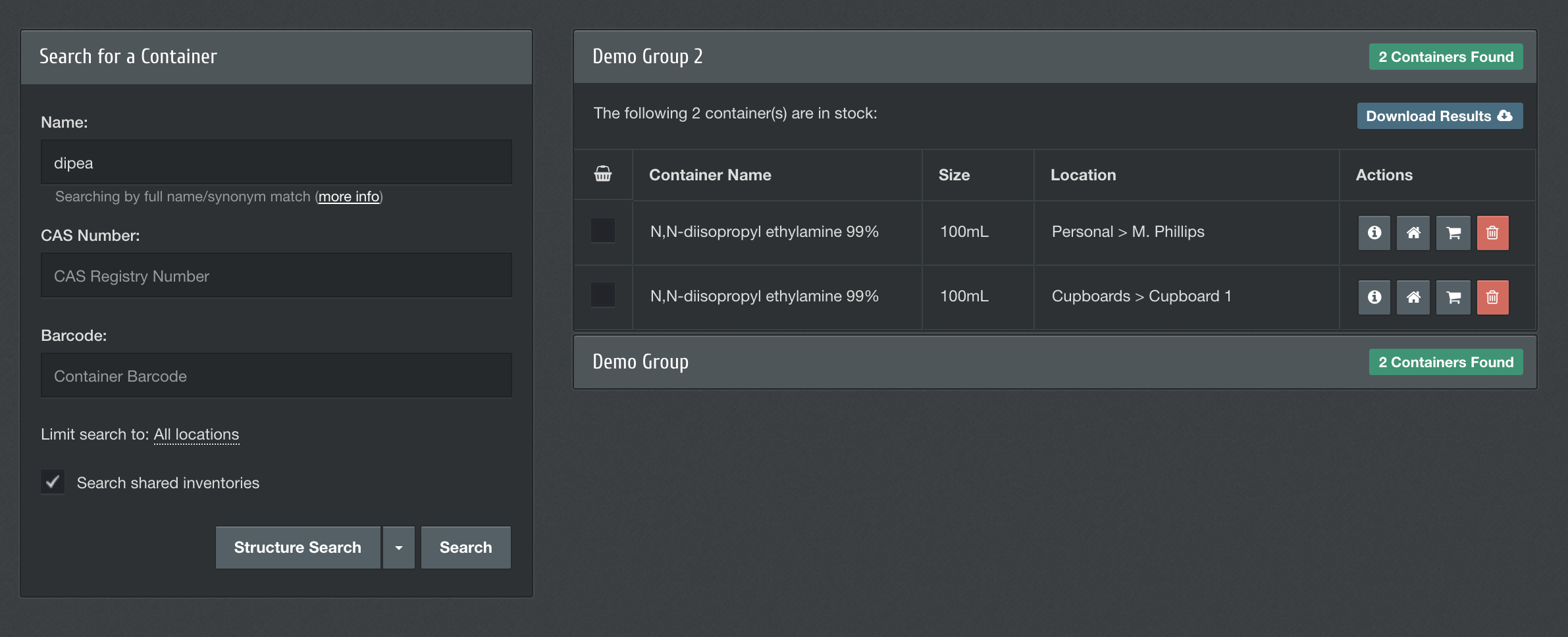Search methods
There are a number of methods that can be used to find containers in your inventory. The most common are searching by Name, CAS Number or Barcode, which have dedicated text fields available on the left. If your inventory has any custom fields that have been defined as Searchable, these will also be listed.
Chemical Synonyms
When containers are added to an inventory, the system will assign synonyms automatically for commercially available compounds which are included by search algorithms when executing name searches. For example, in the screenshot above two results have been found even though the name saved for each container (N,N-diisopropyl ethylamine 99%) doesn't exactly match the search term entered (dipea).
Changing default name search behavior
When executing a name search, by default ChemInventory will only include containers in search results which match the full search term entered. For example, searching for triphenylphosphine will only find containers of that exact substance; results will not be included for compounds which have the search term as part of their name, such as triphenylphosphine oxide.
If you would like to execute more broad searches, for example to find results based on a 'name contains' method, we recommend the use of wildcard characters (see below). You can also change the default search behavior for your user account, by clicking on the more info link just under the name search box.
Wildcard characters
ChemInventory fully supports the use of wildcard characters when running text-based searches. Wildcard characters can be placed anywhere in search terms and represent any number of characters where they're placed. The wildcard character in ChemInventory is the percent sign ( % ). When searching with wildcard characters, synonyms will be considered by ChemInventory.
For example, to find any containers holding material ending with "bromide" you could run a name search for %bromide. Likewise, anything starting with "phenyl" can be found with phenyl%. It is possible to enter more than one wildcard character in a search term, such as %benzyl% to find containers with "benzyl" anywhere in their name.
Structure Search
ChemInventory includes a structure search tool which enables you to find results from your inventory based on chemical structure. Both exact and sub-structure searches can be defined. Drawing fragments with defined stereocenters are fully supported. Results will be found using structures which have been assigned both automatically (for example for commercially available compounds) and manually to your containers (for example in-house made compounds).
To open the structure search tool, click on the Structure Search button at the bottom of the search interface.
Advanced Search
The Advanced Search tool enables you to construct multi-component queries to run against your database. For more information about this tool, please visit its support page .
GHS Search
ChemInventory's GHS functionality allows you to run searches against your inventory by defined hazard. For example, if you would like to find all containers which are both flammable and carcinogenic, the GHS search can be used. More information about the GHS search tool can be found on the GHS support page .
Searching by location
When running a search, it is possible to limit the locations where the search is conducted. When this setting has been enabled, ChemInventory will only list results for containers which are in the selected location(s).
To limit your search to containers held within certain location(s), click on the dotted text alongside the 'Limit Search To:' option. An interface will open which lists all locations in your inventory, as well as the locations hierarchies in any other inventories which have 'Full' sharing set with you. Select your location(s) of interest by checking or unchecking locations and branches.
Search results
Any containers which are found during a search will be listed in a result table to the right side of the page. By default, the information shown in results tables will include container names, sizes and locations. Users with Group Administrator privileges are able to customize columns which appear in tables. Any matching results found in your inventory's Current Orders list will also be included.
If your search includes other inventories, for example those shared with you, results will be grouped by inventory name. You can expand results from each inventory by clicking on the name displayed. In the screenshot above, results from two inventories are shown.
Interacting with results
You can interact with container records directly from search results. This includes moving a container to a new location (using the Move Container button) and deleting containers from your active inventory. You can also view full container information by clicking on the container's name or the View container information button to the right listed results.
When hovering your mouse over the container names listed in the results table, a pop-up box will be displayed which shows the structure of the container along with its CAS number and barcode, if these have been assigned. A checkbox is displayed to the left of each result which adds My Collection functionality.

